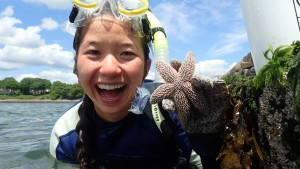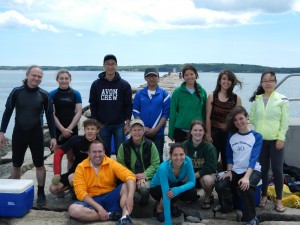A few months ago, researchers from the Coastal Studies Center traveled up the coast to Rockland, a scenic, artsy fishing town with some fantastic marine life. Students and professors from the College of William and Mary, Stony Brook University, and Bowdoin College donned their snorkel gear and wet suits before they walked down the nearly mile long interconnected slabs of granite known as the Rockland Breakwater.

The goal for the day was to collect sea stars and sea urchins for various projects at the college. Amy Johnson’s lab is working with the biomechanics of the various species—how their size affects how they move. Jon Allen’s lab (from William and Mary) is studying elements of sea star reproduction through experimentation.
Sea stars of all sizes were easily found in cracks and behind some of the larger rocks, out of the way of direct wave exposure. Sea urchins were grouped in colonies, and could be particularly difficult to pry off of the rock surface, not only because of their spines, but because when you removed one, all of the others in the area would cling tighter to the rock.

There were occasional hazards, primarily slippery rock, sharp barnacles, and very, very cold water. Despite the 80 degree day, the water was in the low 50s and researchers needed frequent breaks to warm up.
At the end, researchers sorted out the findings into what they needed–sea stars and urchins that would live in the marine lab for the remainder of the summer, throwing back all those that would not be used for research.
Interested in how sea stars move? Check out this underwater video filmed in the Marine Lab from David Conover’s Sea Shore Digital Diaries course from last year.